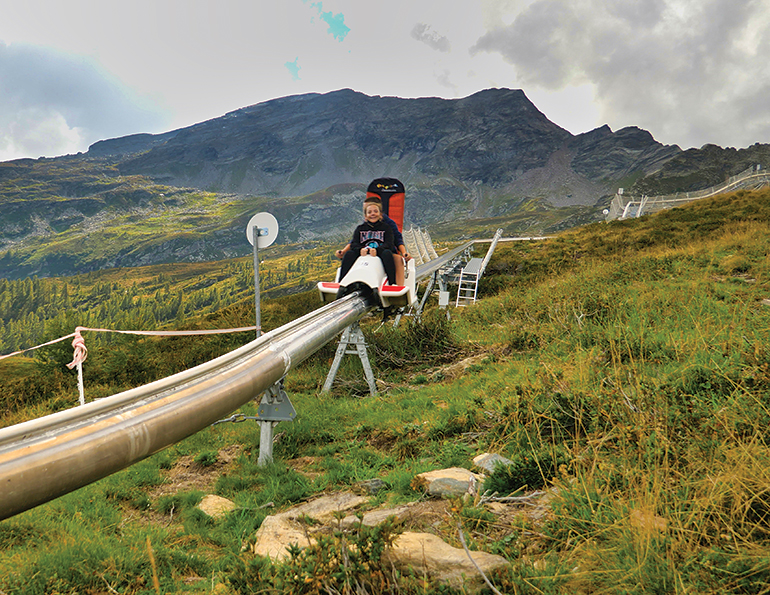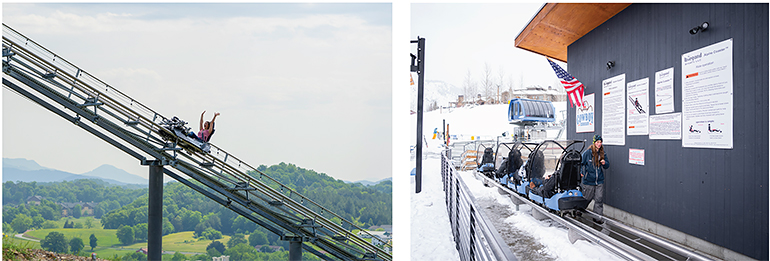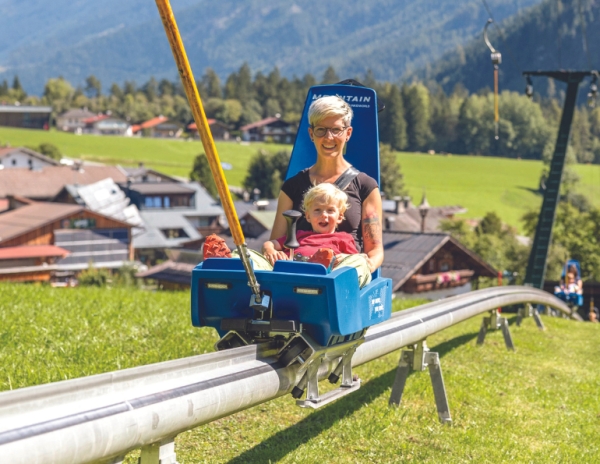When Jiminy Peak, Mass, installed a Wiegand alpine coaster in 2006 as part of a major investment in year-round operations, staff didn’t realize it would remain one of the resort’s most popular attractions nearly two decades later.
“We’ve been a big fan of the coaster. We consider it a signature ride,” says Tyler Fairbank, CEO of The Fairbank Group, which owns Jiminy and Cranmore, N.H., and manages Bromley, Vt. “From an investment, throughput, and staffing perspective, it continues to be good.”
Though coaster installs at mountain resorts may have slowed since those early days—NSAA’s Kottke Report shows the number of responding ski areas with a mountain coaster or alpine slide a steady 12-14 percent for the last five seasons—they may be gaining momentum once again. Longtime manufacturers Weigand and ADG Mountainsides have introduced 2.0 versions of their coasters. Several European suppliers, including MND from France and Austria's Sunkid, have recently introduced new coaster products to the North American market as well.
Demand trending up. At ADG, business development manager David Keim says demand is “trending higher” than pre-pandemic levels, with ski resorts driving 75 percent of the market.
“Ski resort demand continues to lead the pack, but we are seeing increased interest from non-ski-related businesses as well,” says Keim. “As costs continue to stabilize and more markets become aware of coasters, we anticipate that demand will continue to grow.”
Sunkid, whose engineers have spent the last few years tweaking elements of its coaster to meet U.S. standards, also reports a “strong interest in the U.S. market,” says Larry Hays, who oversees the company’s North American coaster business for Leisure Labs. U.S. site visits are being scheduled this summer, with anticipated delivery in 2025, he says. Several installs have been completed in Canada, the most recent at Revelstoke (2023) and Cypress Mountain (2021), with another slated at Panorama this summer.
WHAT’S NEW
Massanutten, Va., is in the process of installing the first MND Fun Coaster in North America, with plans to have it up and running year-round in June. Resort staff had been on the hunt for an activity to replace a canopy tour and to augment an existing lineup that includes a zip line, adventure course, climbing wall, and summer tubing.
Monorail design. The Fun Coaster had appeal for a variety of reasons, says Massanutten director of mountain sports Kameron Tucker, including its monorail design—a diversion from the traditional two-track coasters.
 MND’s Fun Coaster has a monorail design, pictured here in Bosco Gurin, Switzerland.
MND’s Fun Coaster has a monorail design, pictured here in Bosco Gurin, Switzerland.
“We wanted to be able to differentiate from other regional coasters,” says Tucker, who will succeed longtime Massanutten director of sports and risk management Kenny Hess in July. “The monorail design offers a different experience and ride.”
Sunkid’s coaster also utilizes a single-rail design, which Hays says requires less support structure and potentially less money to install.
Anti-collision technology. ADG has no plans to move away from its “tried-and-true” two-rail design, which Keim says still comprises more than 95 percent of North America sales, but it has introduced its “Advanced Positioning Monitoring System 2.0,” anti-collision technology in which Bluetooth overrides manual braking when sleds are within 80 feet of one another, gradually reducing speed until space opens. Such technology has now become standard among all manufacturers.
 Ski resorts are driving the coaster market, says ADG. Pictured: ADG coaster at Purgatory, Colo.
Ski resorts are driving the coaster market, says ADG. Pictured: ADG coaster at Purgatory, Colo.
Speed caps. When shopping around, Tucker notes that Massanutten also appreciated technology that allows the ability to cap coaster speeds—in its case, at 24 mph.
“Some of the earlier coaster installs may have been faster than that and had to be dialed back,” she says. “Like one coaster that was 7 minutes uphill and only a minute down. We didn’t want to get into that.”
Other notable new features and upgrades among manufacturers include: an onboard automatic braking system at MND that recharges during the descent phase to avoid recharge time at the station; an option at Sunkid to transport sleds uphill via a custom attachment on an existing chairlift, gondola, or T-bar; the capability to remove and store a certain length of track to free up winter ski runs, also from Sunkid; and the “Coaster Kart” at Wiegand, a powered version of the Alpine Coaster that can be built on flat ground.
WORTH IT?
For resorts that include a mountain coaster as part of a broader summer operations plan, the ride can generate significant interest and income. As a signature attraction, a coaster can do $500,000 or more in ticket revenues. The opportunity for year-round operation and higher throughput—made possible by coaster 2.0 innovations—opens the door for even greater revenue potential. All this helps explain the renewed interest in coasters.
Suppliers say ... Capacities are ample to generate a good return on investment. MND touts its Fun Coaster’s capacity at “up to 700” rides per hour, says sales director Dennis Kinsella, while Sunkid promotes its capacity at 500 per hour. (“Theoretically,” adds Hays, “but that’s linked to operations, so it’s typically more like 200 to 300.”) Hays notes that Revelstoke’s coaster runs 80,000-90,000 rides over a four-month period, while one at Breckenridge, Colo., clocks several hundred thousand rides a year.
At Wiegand, designer Jacob Watabe estimates the initial investment on a coaster is paid off within two to three years, despite supply chain issues and inflation. Hays estimates an average 12- to 36-month ROI for Sunkid coasters.
Ski areas say ... From an ROI standpoint, Fairbank says the mountain coaster at Jiminy consistently checks two important boxes: high throughput and low staffing requirements. “That’s a driver of the bus for us.”
Jiminy’s coaster averages 50,000-75,000 rides during its busy summer season (vs. about 4,000 during winter) and operates with a staff of four, says assistant GM of mountain ops Jason Griffin. Riders in the summer pay $15 (54”+ tall) or $10 (under 54” tall) per single ride, with unlimited rides included with a Mountain Adventure Park admission.
For The Fairbank Group, the coasters are part of a bigger approach that it has taken since the 1970s, when Jiminy put in an alpine slide, and when focus turned to ancillary income from summer and fall operations, says Fairbank.
“The idea is not huge amounts of revenue as much as the ability to keep high-quality people working for us year-round,” he says. “[Jiminy’s] coaster has been a big contributor to that.” (The Fairbank Group also installed a coaster at Cranmore in 2010.)
Consistency. Massachusetts’ Berkshire East installed an ADG Mountainsides coaster in 2014 as part of its significant investment in summer ops. Since then, coaster visits have remained stable with “a consistent ridership that hasn’t grown dramatically but hasn’t shrunk,” says general manager Melissa Roberts.
“It’s a fun family activity that doesn’t take up the whole day vs. rafting and zip lining,” says Roberts. “We’re trying, like a lot of ski areas, to continue to enhance summer ops, and that’s been a nice complement and a nice revenue source. We’re definitely pleased to have it.”
The coaster, which runs from Memorial Day weekend through October, appeals to Berkshire East’s predominantly day-market clientele. The resort sells adult single-ride, three- and ten-packs ($20, $49, $149) that are transferrable. “A family of four will buy a ten pack and go two to three times,” says Roberts. “It makes it an affordable option and hopefully they stick around and have some food.”
Roberts correlates summer coaster users with the winter tubing demographic—“people looking for something to do but not ready for zipping or rafting.” It’s cross-promoted with the resort’s two zip courses, rafting operations, and aerial adventure park, which helps reach a different group. (Interestingly, its summer mountain biking crowd, which the resort has catered to in recent years, doesn’t provide much ridership. However, a campground built for them does provide an opportunity for more overnight visitors in general.)
The study says ... Massanutten, which conducted an extensive ROI feasibility study before deciding to move forward, projects 75,000 riders per year and a three-year ROI on its new coaster. “A lot of that is from looking at Adventure Park Insider State of the Industry Report average numbers across the country for mountain coasters,” says Tucker.
That the resort already had a ticketing facility, parking, and restrooms at the location made the build feasible. “It didn’t affect ski operations at all,” Tucker says. “We’re building a bridge over the road (to accommodate the 3,400-foot looped footprint) but didn’t have to mess with any existing ski terrain.”
CONSTRUCTION COSTS?
Pandemic fallout continues to impact the cost of a coaster installation, including “significant increases” in costs for raw materials, contractors, construction materials, and labor, notes Keim.
“These cost increases result in an increased first cost for a coaster installation, which with all things remaining the same, extends the ROI timeframe or is offset by increased admission costs and/or increased attendance,” he says.
The additional costs gave Massanutten something to contemplate but were deemed not prohibitive, says Hess. “The return may have been quicker in the past,” he says, “… cost overruns will certainly extend the ROI. But we have not seen anything that would suggest buyer’s remorse.”
NUTS AND BOLTS
As with any equipment, an aging mountain coaster must rely on some sort of maintenance and upgrades. There are key parts to replace and annual state-mandated inspections, at the very least.
Berkshire East has had to replace small items, and there are associated annual maintenance costs to keep in mind, says Roberts.
“It’s not prohibitive, but it’s certainly not a cost-free investment,” she says. “Annual maintenance and inspections are required. It gets licensed every year. It’s not as expensive as maintaining a chairlift or even the bike trails, but more expensive than, say, the zip lines.”
At Jiminy, a small sum is spent each year on coaster maintenance and repairs. “Our coaster is all stainless steel, but we do spend some on lumber (installed anywhere the track is more than three feet above ground) and to change the haul cable every year,” says Griffin. “Wheels wear down, etcetera, but it’s still a profitable ride for us. We probably spend more on maintenance than on any other ride, but pound-for-pound, it’s worth it with what the coaster makes.”
Griffin says the coaster is inspected every day they’re in operation and must have annual state and third-party inspections—two outsourced inspections in addition to in-house efforts.
Jiminy also swapped out some of the elements of its original coaster, which was pricey up front but a good investment, he adds. This included installing a Wiegand Intelligent Distance Control System in 2019, which runs on an eddy current and, as with ADG’s product, keeps the sleds from getting too close.
 Mountain coasters can operate year-round. Pictured: Wiegand coasters at Snow King, Wyo. (above), and at Skyland Ranch, Tenn. (left).
Mountain coasters can operate year-round. Pictured: Wiegand coasters at Snow King, Wyo. (above), and at Skyland Ranch, Tenn. (left).
“The biggest benefit to the upgrade is the fact that the sleds cannot collide,” says Griffin. “But (this also) allows us to send sleds every 15 seconds. When we first introduced the coaster, slow people were a bottleneck. We would space the guests out more to give them more room.”
The upgrade has enabled the coaster to run 240 riders per hour, says Griffin. “The eddy current was an expensive upgrade, but it will last forever,” he adds.
A SMART MOVE
“For us, it was a real departure to be a year-round operation,” Fairbank says. “The intent was really to have a well-rounded resort with strong summer ops that could blend into the fall. The coaster has been a big contributor to that. I think it’s one of the smartest things we ever did.”
“I look at it from a fun aspect of things,” adds Griffin. “I still get the same childish thrill as the first time I rode it—it’s that level of fun.”






